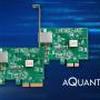You guys know I've been evangelizing 5G and 10Gbit/s Ethernet to be embedded into motherboards for a while now. Well, Aquantia is pleased to offer a special holiday promotional pricing for our 5G and 10G AQtion NIC products. At $59.00 and $69.00 respectively.
San Jose, Calif. – Nov. 21, 2017 – Aquantia Corp., (NYSE: AQ), a leader in high-speed, Multi-Gigabit Ethernet connectivity solutions, today announced its plan to help PC gamers and hardware enthusiasts squeeze new levels of performance out of their systems. Today, Aquantia announced a special holiday promotion with international distribution partners Arrow, WPGA and WPI, to deliver the industry’s fastest Ethernet adaptors – Aquantia AQtion Network Interface Cards (NICs) – to gamers and performance PC users at a giftworthy pricepoint for a limited time. On Black Friday, November 24th, the Aquantia AQtion AQN-108 5G NIC will be available for $59.00 and the Aquantia AQtion AQN-107 10G NIC will be available for an unprecedented $69.00.
The super-low latency and in-game advantage that AQtion Multi-Gigabit NICs deliver make them the perfect holiday surprise for any hardware enthusiast. The performance PC user – whether a gamer, video editing enthusiast, designer, engineer or just a tried and true geek – wants the ability to move huge volumes of digital life data seamlessly and quickly. In a home or office, that seamless capability requires a 5G or even a 10G NIC card.
Kamal Dalmia, Senior Vice President of Marketing and Sales, said: “Typically, gamers and performance PC enthusiasts are on the leading edge of technology trends. Given the substantial uptick in interest we have seen for Multi-Gig PC Access solutions in the past year we thought it would be great to kick off the holiday season with a special promotion for those users. Not only do they get outstanding Multi-Gig Ethernet performance, but they get bragging rights over their pals who are still using outdated, 17-year-old single gigabit technology.”
The AQtion AQN-108 NIC supports 5G and 2.5G Ethernet speeds over standard Cat 5e and Cat 6 copper cables. Compliant to IEEE 802.3bz standard, these adapters are also backward-compatible with legacy 1000BASE-T Ethernet. The AQtion AQN-107 NIC has the added benefit of supporting 10GBASE-T Ethernet in compliance with the IEEE 802.3an standard. By supporting PCI Express x4 and x1 versions with a single RJ45 port, these new Aquantia NICs can be used to easily upgrade existing PCs and new models to fully utilize the bandwidth capabilities of modern CPUs and GPUs.


